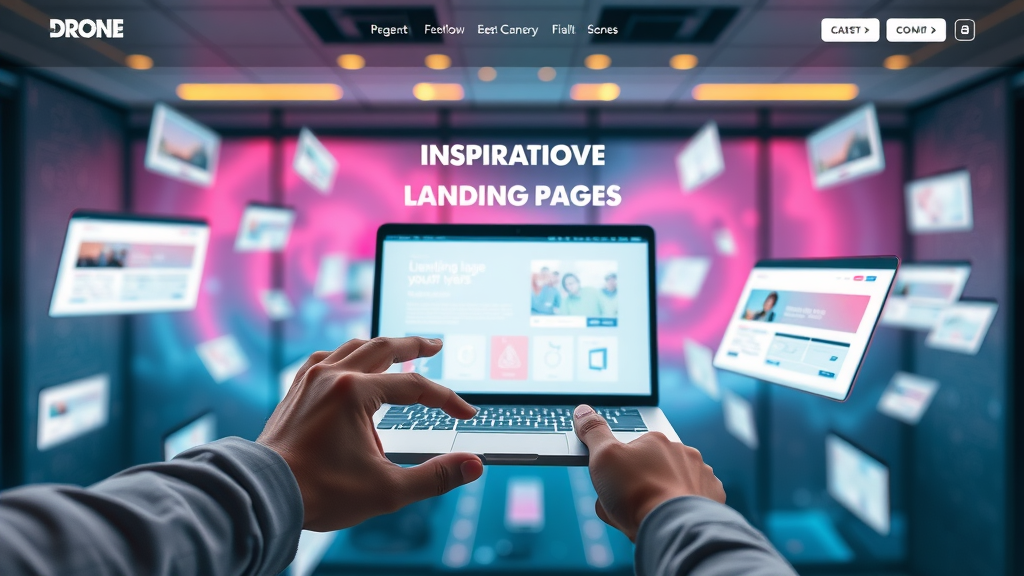- Did you know that 80% of landing page designs fail to convert due to avoidable mistakes? Discover how optimizing your landing page design can dramatically increase your conversion rate.
Mastering Landing Page Design for Maximum Conversion
- Explore why effective landing page design is crucial for your campaign success and see how poor page design can sabotage your results.
In today’s competitive digital marketing landscape, landing page design is no longer just about aesthetics—it’s about survival. A page filled with cluttered sections, weak calls to action, or slow load times can lose prospective leads in seconds, wasting valuable marketing spend. High-conversion landing pages are carefully crafted to guide users smoothly toward a single, measurable goal. For example, a well-designed lead generation page with a concise headline and a prominent button can outperform a cluttered page with multiple distracting options. Marketers investing in good landing page design have consistently reported improved campaign performance and better ROI. Whether you’re running paid ads, social media promotions, or email marketing, your landing page is the linchpin of user engagement. With the right design principles in place, you transform casual visitors into actionable leads or customers. Before launching your next campaign, ask yourself: is your page design boosting or killing your conversions?

“A well-designed landing page can increase conversion rates by up to 300%.” – ConversionXL
Key Elements of Landing Page Design: What You'll Learn
- The most common landing page design mistakes
- Actionable strategies to improve your landing page conversion rate
- Great landing page examples and inspiration
- Critical landing page template tips
- Landing page builder tools for high-performing designs
Understanding Landing Page Design: Fundamentals That Influence Success
What is a landing page design?
- A landing page design refers to the visual layout, structure, and conversion-driven elements that guide visitors toward a single call-to-action.
At its core, landing page design is not only about how your page looks, but how effectively it drives users towards a singular goal. Unlike traditional web pages, a good landing page removes distractions and eliminates unnecessary navigation to keep the focus sharp. Its layout, color palette, and font size are carefully chosen to highlight a compelling offer and direct attention to where you want action—usually a button or form. Converting landing pages employ proven principles such as visual hierarchy, headline clarity, and concise messaging. When you design a landing page, every element should serve a purpose: from descriptive imagery that supports your value proposition to a clear and contrasting CTA button. The smoother the user's journey, the higher your conversion rate climbs.

How do I create a landing page?
- Creating a landing page starts with a clear goal, engaging content, compelling visuals, and a strong call to action, often built using specialized landing page builder tools or platforms.
To create a landing page that converts, start by defining exactly what action you want users to take. Is it to sign up for a newsletter, download a free guide, or make a purchase? Once the goal is clear, choose a landing page builder or use templates from popular platforms to speed up development while maintaining quality standards. Structure your content with a powerful headline, value-driven copy, and a focused layout. Make your CTA button prominent and persuasive, using action-oriented language and contrasting colors for visibility. Don’t forget to test your design on both desktop and mobile devices to ensure everyone gets a seamless experience. Many modern page builders offer drag-and-drop simplicity, built-in analytics, and even A/B testing to further optimize your landing page design.
How much does it cost to have a landing page design?
- Landing page design costs can range from $100 for DIY tools to $2,500+ for professional designers, depending on features, complexity, and the use of landing page templates.
The price of landing page design is influenced by several factors: the expertise of your designer, the complexity of page features (like animations), and whether you use page templates or opt for a fully custom design. For small businesses or individuals, affordable DIY options through landing page builders can be a powerful tool—often under $100 per page. Meanwhile, professional agencies may charge several thousand dollars for a bespoke solution that includes custom graphics, A/B testing, and strategic consultation. Ultimately, investing in a good landing page design can pay off through higher conversion rates and a better return on your marketing spend. Many businesses start with a template to test their message, then scale up to custom designs as campaigns grow.
Are landing pages still a thing?
- Absolutely. Landing pages remain an essential component of digital marketing strategies because they're proven to drive targeted conversions.
Despite the evolution of digital marketing channels, landing pages remain crucial for delivering focused experiences that turn visitors into leads or customers. Whether used for PPC ads, social media promotions, or email marketing, a great landing page is finely tuned to solve a visitor’s problem or meet a specific desire. Marketers across industries continue to leverage landing pages because their simplicity and clarity outperform generalized webpages. In short, if your business runs any online marketing campaigns, you need optimized, converting landing pages in your strategy. As new tools, templates, and page builder platforms emerge, getting a good landing page up and running is easier—and more important—than ever.
Top Landing Page Design Mistakes That Lower Conversion Rate
Overwhelming Page Design With Clutter
- Too many elements, confusing layouts, and distracting visuals hinder your message and dilute your landing page’s effectiveness.
One of the biggest conversion killers is a page design that tries to do too much. When visitors are greeted by walls of text, competing call-to-action buttons, or multiple navigation links, they’re more likely to bounce away than take action. Effective landing page designs intentionally remove clutter—limiting themselves to essential content, logical structure, and a single goal.
Keep font size consistent , use white space generously, and choose images that reinforce your offer rather than distract from it. If you need inspiration, look at landing page examples from industry leaders: they favor simplicity and direct, actionable information. Periodic audits of your existing landing pages often reveal hidden distractions or features that can be streamlined for user clarity.

Unclear Headlines and Poor Messaging
- Landing page headlines must be concise, relevant, and instantly informative to guide users toward your conversion goal.
A weak or ambiguous headline is often the first thing that drives visitors away from your good landing page . Your headline should answer the prospect’s main question: “What’s in it for me?” In the reverse pyramid of communication, the headline carries the most weight. Landing page examples that perform best typically use headlines that are straightforward, benefit-focused, and in large, readable font sizes.
Avoid jargon or buzzwords. Instead, address your visitor’s pain point using clear, direct language, and keep supporting text easy to scan. Spend time testing and refining your headlines—something as simple as a single word change can have a dramatic impact on your conversion rate. A/B testing multiple headline options with a good landing page builder is a must for maximizing campaign performance.

Weak Call-To-Action (CTA) Placement
- Ineffective CTAs or poorly placed conversion buttons result in diminished engagement and lost leads.
Even the most engaging content can't save a landing page design with a buried or confusing call-to-action. Your CTA should always be the most visible, attention-grabbing element on your page. Position it above the fold, use contrasting colors for the button, and write conversion-focused copy. A poorly placed CTA—a button hidden at the very bottom of a lengthy page, or surrounded by too many competing links—creates confusion for your visitors. Use heatmaps and analytics to see where users drop off, then experiment with button placements and design inspiration from top-performing page examples. The difference in conversion rates can be dramatic simply by optimizing CTA visibility and positioning.
Slow Loading Landing Pages
- Page speed is critical; slow landing pages can increase bounce rates and hurt conversion rate drastically.
In the age of instant gratification, if your landing page takes more than a couple of seconds to load, you risk losing up to half of your potential leads. Google research shows that as page load time goes from one second to five seconds, the probability of bounce increases by 90%. Optimize your landing page images, minimize scripts, and use a reliable hosting provider to keep load times fast. Leading landing page builders come with built-in optimizations for image compression and caching—be sure to use them. Continuous monitoring and regular speed checks should be routine, especially after making design updates or adding new media elements.
Great Landing Page Design Principles: Inspiration From Top Landing Page Examples
| Landing Page Element | Good Landing Page Example | Bad Landing Page Example |
|---|---|---|
| Headline Clarity | Direct, benefit-driven: “Get Your Free Marketing Guide Now” | Vague, unclear: “Welcome to Our Website” |
| CTA Prominence | Large, colorful button above the fold: “Start Free Trial” | Small, hard-to-find button at the bottom of the page |
| Visual Hierarchy | Consistent font sizes, bold headlines, focused sections | Clashing fonts, no order, scattered information |
| Mobile Responsiveness | Easy navigation, fast load, readable on all devices | Broken layouts, tiny text, poor mobile UX |
Effective Use of Landing Page Templates and Page Builders
- Utilize landing page builder tools to quickly apply successful landing page templates and best practices that save time and improve performance.
Page builders and proven templates are a powerful tool for marketers needing to get landing pages live quickly without compromising on conversion best practices. These platforms offer a variety of high-performing page templates and page ideas tested for effectiveness, so you don’t have to start from scratch with every marketing campaign. Landing page builder solutions include A/B testing, analytics, and responsive design to streamline your workflow. When selecting templates, look for features like clear headers, spacious layouts, and mobile-first design. The right builder not only accelerates your setup, it empowers even non-designers to experiment, iterate, and fine-tune landing pages until they deliver maximum results.
Video walkthrough: Analyzing great landing page design examples vs. common design mistakes
Page Design Optimization: Proven Tactics to Boost Landing Page Conversion Rate
Crafting Great Landing Page Headlines
- Write clear, benefit-driven headlines that match your user's intent and build trust instantly.
A high-converting headline addresses your audience’s primary need or desire in just a few words. Use bold font size and contrasting colors to grab attention instantly. Great headlines communicate the unique value of your offer and set expectations—for instance: “Unlock 20% More Appointments—No Credit Card Required.” In the best landing page examples , the headline is always above the fold and closely supported by a compelling subheading. A/B testing with your target audience (using your landing page builder’s built-in tools) helps identify the messaging that resonates best and maximizes your conversion rate.

Streamlining Landing Page Forms
- Reduce form fields to only essential information to lower friction and improve overall conversion rates.
Long, complicated forms are an instant turn-off. Studies show that reducing form fields from five to three can increase conversions by up to 50%. Ask only for necessary details—like just an email address, instead of name, phone, company, and role. Simplicity in your form’s appearance makes your landing page design more inviting. Use large, clearly labeled fields and error-proof validation to minimize frustration. The best landing page templates demonstrate how fewer fields and neat design inspiration can result in more signups and greater user satisfaction.

Using Visuals For Maximum Impact in Landing Page Design
- Strategic use of images, icons, and videos communicates your value proposition quickly.
The right visuals can instantly convey trust, showcase products, and direct users toward your CTA. High-quality, relevant images reinforce your message, while short videos can demonstrate product value or explain steps in a marketing campaign. Use icons to break up information, applying them selectively to avoid visual clutter. Always compress your images for faster load times—balancing impact with page speed . Regularly reference landing page examples for ideas on how top brands use visuals to maximize their results and conversion rate.
Case Studies: Great Landing Page Design That Drive Results
- Brief success stories showcasing page templates with strong conversion rates
- Analysis of landing pages before and after optimization
Consider a B2B SaaS brand that switched from a cluttered, text-heavy landing page to a clean design with a direct headline and a single CTA—conversion rates shot up from 2% to 8%. By leveraging high-converting page templates , another e-commerce brand improved mobile performance, leading to a 40% increase in mobile sales. These case studies highlight the compounded effect of smart design changes and ongoing A/B testing. They also demonstrate how starting with great templates and learning from landing page examples accelerates your ability to reach—and exceed—campaign goals.
Landing Page Design Inspiration: Examples and Templates
- Showcase of page examples from industry leaders
- Curated landing page designs featuring different conversion goals
Draw inspiration from leading brands like HubSpot, Shopify, or Unbounce. Their landing page designs prioritize fast load times, compelling headlines, and fast navigation, regardless of device. Explore page examples across different industries for ideas that match your audience and campaign objective. Whether you’re seeking design inspiration for a lead gen campaign, a webinar signup, or a product launch, reviewing curated landing page templates helps you discover what works for turning visits into conversions. Always borrow from the best, then tailor layouts and content to fit your brand’s voice and marketing strategy.

Expert Quotes on Landing Page Design and Conversion Rate
“Simplicity and clarity are the foundation of every great landing page.” – Unbounce
“A/B testing is the backbone of effective landing page design.” – Hubspot
People Also Ask: Addressing Common Landing Page Questions
What is a landing page design?
- Landing page design is the process of strategically arranging visual and written elements to maximize conversions on a single, dedicated page.
Landing page design strategically blends visuals and words to move your target audience toward a clearly defined action. Unlike multipurpose homepages, a good landing page strips away distractions and zeroes in on one message. From font size and color choices to the layout of image and CTA, each piece is tested and optimized for conversion.
How do I create a landing page?
- Start by defining your goal, then use a landing page builder and proven templates to design a focused page that drives users to take one conversion action.
To create landing pages that deliver results, define the single conversion you want—like collecting email signups or leads. Next, pick a trusted page builder platform with highly-rated page templates built for speed and conversion. Apply your own brand voice, include clear value statements, and launch A/B tests to keep improving your page ideas based on user response.
How much does it cost to have a landing page design?
- Costs vary widely but expect to pay from $100 for a DIY page using page templates to $2,500+ for custom landing page design from an agency.
Entry-level landing page design costs start low with DIY builders and templates, but full custom agency work may run $2,500 or more. The best approach is to match your investment to campaign needs—testing page ideas and templates before committing to upscale, custom solutions as your business grows.
Are landing pages still a thing?
- Yes, landing pages are still vital—they are essential for digital campaigns intended to capture leads, signups, or purchases.
Absolutely. Landing pages remain at the center of digital lead generation, product launches, and targeted marketing campaigns . They simplify the user decision and consistently outperform generic multipurpose pages. Every industry with an online marketing component benefits from mastering the art and science of landing page design .
Landing Page Design Frequently Asked Questions
- What are the first steps to optimize landing pages for higher conversion?
- Can landing page templates work for all industries?
- How does mobile-first design impact landing page success?
To optimize a landing page for better conversion rates, audit its clarity, streamline the headline and CTA, and ensure it loads quickly on all devices. Yes, proven landing page templates can be customized for nearly any industry—just tailor the voice, imagery, and lead form fields to match your target audience . Finally, mobile-first design is now a necessity: most conversion actions happen on mobile, so always prioritize fluid layouts, tap-friendly buttons, and swift load times for your landing page design.
Action Steps: Avoid Landing Page Design Mistakes and Unlock Higher Conversions
- Audit your existing landing pages for design clarity
- Implement A/B testing on headlines and CTAs
- Upgrade to responsive landing page templates
- Reduce loading times with optimized images
- Use a trusted landing page builder to streamline design
Summary: Key Takeaways on Landing Page Design and Conversion
- Clear, concise landing page design increases conversion rates
- Avoiding clutter and focusing on a single CTA is critical
- Using high-quality page templates and builders saves time and boosts results
Start Improving Your Landing Page Design Today
- Ready to transform your conversions? Apply these landing page design best practices, explore top landing page templates, and watch your results soar!
Conclusion
Start now—review your landing pages, implement proven design tactics, and use reputable builders to turn every visit into a conversion win.
Sources
ConversionXL – https://conversionxl.com/blog/landing-page-principles/ Unbounce – https://unbounce.com/landing-page-articles/ HubSpot – https://www.hubspot.com/products/landing-pages Optimizely – https://www.optimizely.com/optimization-glossary/landing-page/
To enhance your understanding of effective landing page design and avoid common pitfalls, consider exploring the following resources:
-
“Landing Page Design Best Practices - Instapage Guide” : This guide offers comprehensive strategies to optimize your landing pages, including tips on removing navigation links to maintain visitor focus and ensuring fast page load speeds to reduce bounce rates. ( instapage.com )
-
“How to create a landing page with high ROI [+ expert and data-backed tips]” : HubSpot’s article provides expert advice on crafting high-converting landing pages, emphasizing the importance of clear CTAs, mobile responsiveness, and the strategic use of color to draw attention to key elements. ( blog.hubspot.com )
By delving into these resources, you’ll gain valuable insights and practical tips to refine your landing page designs, ultimately boosting your conversion rates.
 Add Row
Add Row  Add
Add 




Write A Comment